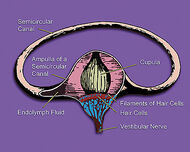Assessment |
Biopsychology |
Comparative |
Cognitive |
Developmental |
Language |
Individual differences |
Personality |
Philosophy |
Social |
Methods |
Statistics |
Clinical |
Educational |
Industrial |
Professional items |
World psychology |
Biological: Behavioural genetics · Evolutionary psychology · Neuroanatomy · Neurochemistry · Neuroendocrinology · Neuroscience · Psychoneuroimmunology · Physiological Psychology · Psychopharmacology (Index, Outline)
| Cupula | ||
|---|---|---|
| Inner ear illustration showing semicircular canal, hair cells, ampulla, cupula, vestibular nerve, & fluid | ||
| Latin | cupula cochleae | |
| Gray's | subject #232 1051 | |
| System | ||
| MeSH | [1] | |
| [[Image:|190px|center|]] | ||
The cupula is a structure in the vestibular system, sensing proprioception.
The cupula is located within the ampullae of each of the three semicircular canals. As fluid rushes by the cupula, hair cells within it sense rotational acceleration, and transmit the corresponding signal to the brain through the vestibulocochlear nerve (CN VIII)
In their natural orientation within the head, the cupulae are located on the medial aspect of the semicircular canals. In this orientation, the kinocilia rest on the posterior aspect of the cupula.
Effects of alcohol[]
Further reading: Short-term effects of alcohol#vertigo
Alcohol causes vertigo by affecting the cupula; the cupula floats in a fluid called the endolymph which is the same density as that of blood. As alcohol dilutes blood in the cupula, the cupula becomes less dense and rises. The cupula is thus sensitized, and responds to movement by sending more action potentials to the brain, "confusing" it and causing the common disorientation associated with drunkenness.[1]
Other uses of cupula[]

Alternative use of cupula, i.e. as the apex of the cochlea. The cochlea and vestibule, viewed from above. (upula labeled at upper left.
The bony canal of the cochlea takes two and three-quarter turns around the modiolus. The modiolus is about 30 mm. in length, and diminishes gradually in diameter from the base to the summit, where it terminates in the cupula.
- Cupula also describes a structure surrounding hair cell receptors sensitive to hydrodynamic flow in fish.
- Another use of the term "cupula" is used to describe the cervical pleura in the thorax.
- A layer in the otolith organs is also called cupula.

Illustration of otolith organs, showing another cupula, this time one of the layers.
References[]
External links[]
- http://faculty.une.edu/com/abell/histo/CristaAmp.jpg
- http://www.kumc.edu/instruction/medicine/anatomy/histoweb/eye_ear/ear04.htm
- http://www.anatomyatlases.org/MicroscopicAnatomy/Section16/Plate16314.shtml
- http://education.vetmed.vt.edu/Curriculum/VM8054/Labs/Lab11/Ear/EXAMPLES/Excrista.htm
This article was originally based on an entry from a public domain edition of Gray's Anatomy. As such, some of the information contained herein may be outdated. Please edit the article if this is the case, and feel free to remove this notice when it is no longer relevant.
Sensory system: Auditory and Vestibular systems (TA A15.3, GA 10.1029) | |||||||||||||||
|---|---|---|---|---|---|---|---|---|---|---|---|---|---|---|---|
| Outer ear |
Pinna (Helix, Antihelix, Tragus, Antitragus, Incisura anterior auris, Earlobe) • Ear canal • Auricular muscles | ||||||||||||||
| Middle ear |
| ||||||||||||||
| Inner ear/ (membranous labyrinth, bony labyrinth) |
| ||||||||||||||
| {| class="navbox collapsible nowraplinks" style="margin:auto; " | |||||||||||||||
| |||||||||||||||
|}
